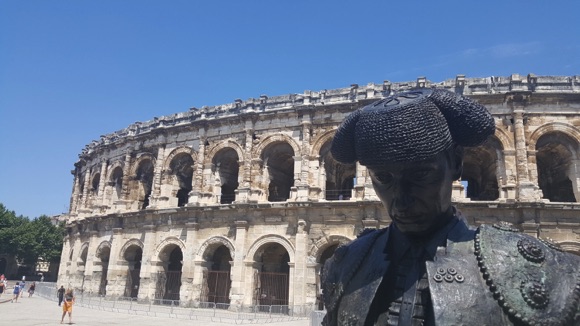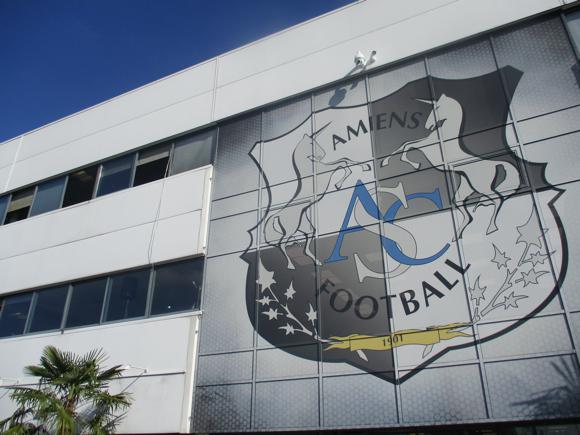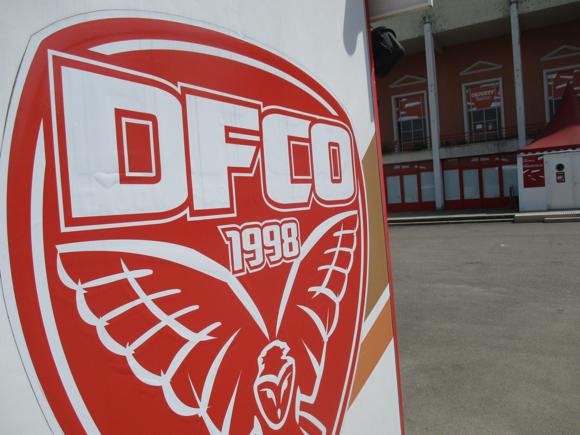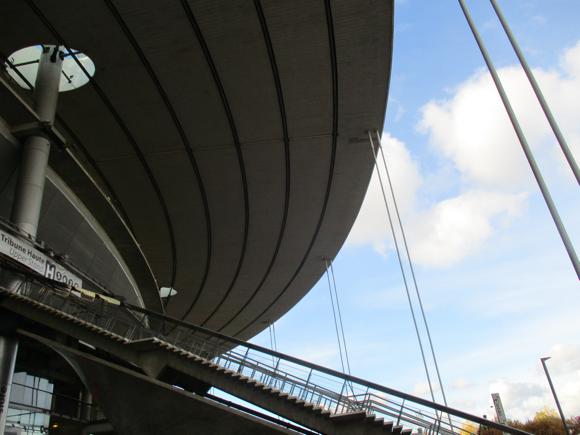A fan’s guide – the club from early doors to today
Their crocodile logo echoing the glory days more than half a century ago, Nîmes Olympique have spent longer out of the top division than playing in it. This negative all-time record may be reversed in the upcoming seasons, Les Crocodiles having returned to Ligue 1 in 2018 after a 25-year absence – but Nîmes have long been overshadowed by their more ambitious and successful regional rivals, Montpellier.
‘Le NO’ were founded in 1937, although the crocodile logo and red shirts had been introduced by Henri Monnier when he set up the first football club here in the early 1900s. Sporting Club Nîmois had embraced professionalism to join the inaugural French Division 1 in 1932-33 but had aimed too high, brought in foreign stars, crashed and burned.

Nîmes Olympique also inherited Sporting’s old ground, Stade Jean Bouin. The new club made its debut in August 1937, against later rivals Montpellier. A solitary win was the only one of that initial season in Division 2 Sud and preceded campaigns played in Vichy France all through the war.
Nîmes remained a middling second-tier outfit until the arrival of Pierre Pibarot in 1948. Revered at nearby Alès, where the stadium takes his name, Pibarot took Nîmes to the top league, partly thanks to a centre-forward he had brought with him from Alès. Marcel Rouvière’s goals not only kept NO in the top ten but pushed gates at the Stade Jean Bouin into five figures.
It also laid the groundwork for the great Nîmes side of the late 1950s. After Pibarot became part of the national set-up for the 1954 World Cup, Rouvière joined Nîmes’ back-room staff headed by coach Kader Firoud. Burly team captain during the promotion season of 1949-50, the Oran-born half-back won six caps for France, making his international debut against England at Highbury. After a car crash curtailed his playing days, Firoud coached Nîmes to three consecutive runners-up spots in the league and two cup finals.

Despite the lack of silverware – NO only debuted in Europe in 1971 – the club was prominent in a strong French league. Top scorer Hassan Akesbi signed by Firoud from FUS Rabat, enjoyed a long career that culminated in him scoring a vital equaliser for Morocco in their successful 1970 World Cup qualifying campaign.
Firoud, in place until Pibarot returned in 1964, also nurtured talents such as Bernard Boissier, Michael Mézy and René Girard, Nîmes stalwarts and French internationals in the 1970s and 1980s.
Firoud himself returned in 1969, with immediate results. Nîmes had dipped in form, even spent a season in Ligue 2, before Firoud snapped up prolific striker Jacky Vergnes from Red Star. A fourth placed finish in 1971 led to a UEFA Cup clash and defeat on away goals to Vitória Setúbal. Runners-up in 1972, Nîmes again fell at the first hurdle in the UEFA Cup, to Grasshoppers of Zürich.

Firoud left to engineer the rise of Nîmes rivals Montpellier, his longevity as a top-league coach only bettered by the legendary Guy Roux.
Despite old boy Mézy on the bench, Nîmes no longer had the stamina to stay in the top flight – although they had the players. A 1986 World Cup star with France and four-time title-winner Philippe Vercruysse headed the Nîmes midfield in the early 1990s, when 10,000-plus crowds gathered to watch his fellow French internationals William Ayache and Éric Cantona. Before his legendary revival across the Channel, Cantona played his last league game in France at Nîmes, showing his displeasure at a refereeing decision and storming off the pitch in December 1991.
Relegated the following season, Nîmes would not experience top-flight football for another 25 years – although, bizarrely, one of the club’s most sensational exploits was at its lowest ebb near the bottom of the third tier. Almost sinking straight down from the second to the fourth divisions in 1995-96, Nîmes captured the public imagination with a run to the final of the French Cup. Heroic wins over Saint-Étienne and, of all teams, Montpellier, took NO to the Parc des Princes. Some 14,000 Nîmes fans saw NO lead Auxerre 1-0 at half-time, only to fall to a late winner by Lilian Laslandes.
Auxerre then did Nîmes a favour by winning the double and giving the third-flight club a passage to Europe. A first victory on the international stage, over Honvéd, led to the visit of AIK and two early away goals by the Stockholm side.

By now, NO were based at the Stade des Costières, built by the municipality by the southern ring road in the late 1980s. Forming part of a surburban leisure and shopping zone, it accommodated gates in the low thousands until Nîmes gained promotion from the third-tier National in 2008.
It would be another decade before the stadium would be filled, with queues round the block for tickets, when Nîmes eventually regained top-flight status with a 4-0 win over Gazélec Ajaccio in 2018. Coach Bernard Blaquart, in place since 2015, steered the side into second place after a weak start to the campaign, Franco-Turkish striker Umut Bozok netting 25 league goals.
Despite Bozok going off the boil, Blaquart managed to anchor Nîmes in the safe waters of mid-table Ligue 1 – a feat he struggled to match in 2019-20.






Stadium Guide
The field of dreams – and the stands around it



Built by the municipality in 1989, the Stade des Costières was sold to NO owner Rani Assaf 30 years later, in the summer of 2019, with the intention of knocking it down and rebuilding it by 2024.
In between, the stylishly blocky exterior designed by Vittorio Gregotti, responsible for the rebuild of the Luigi Ferraris in Genoa around the same time, remains in place. Surrounding a football pitch with no running track in between, the stadium was a brave move, the tenants long stuck in Division 2 attracting crowds of under 5,000.
And, apart from a brief, star-studded season in the early 1990s, the Stade des Costières, named after the wine terroir created by the Romans, would accommodate modest gates until 2018.
Today, average attendances hover around 13,000-14,000, the stadium capacity 18,500. Two stands are covered, the main Tribune Nord and livelier Sud opposite. The home end is the Pesage Est, away supporters are allocated around 900 seats in the Pesage Ouest nearest the Tribune Nord.
getting there
Going to the stadium – tips and timings
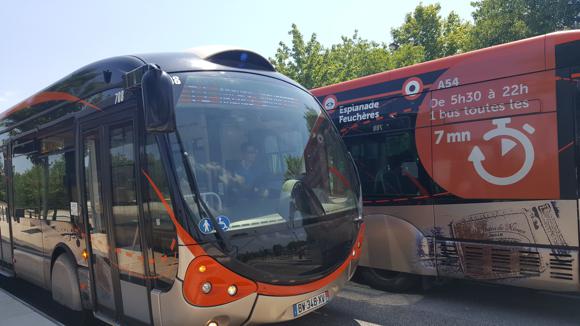

The stadium is on the southern outskirts of Nîmes, too far to walk from the city centre or from Nîmes-Centre rail station. Bus line T1 (every 7-10mins) circles the Old Town, calling at focal Arènes and Esplanade Feuchères near the station, then heads south to the Costières/Parnasse stop by the ground. Allow 10-15mins from town.
The alternative is bus 7 (every 20mins) from Gare Feuchères, which takes longer to reach the same stadium stop.
getting in
Buying tickets – when, where, how and how much

Tickets are sold online through the club or the usual nationwide channels such as Ticketmaster and Fnac.
In person, you could try Bar Joe (44 boulevard Victor Hugo) in town or, on match days, the stadium ticket windows – call +33 4 66 64 66 64 to check availability.
Home fans fill places behind either goal – priced at around €15 – so you’ll be paying around €25 for a seat in the Tribune Est or Ouest.
what to buy
Shirts, kits, merchandise and gifts

The match day-only club shop at the stadium stocks the standard range of crocodile-branded merchandise – away tops are a white/red reverse of the home shirts.
Where to Drink
Pre-match beers for fans and casual visitors

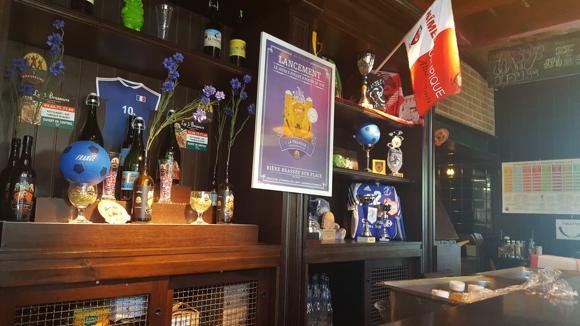



The location where a ring road meets a business park barely inspires but Les 3 Brasseurs on Ancienne Route de Générac is a fine pre-match option. Friendly owner and staff, decent house beers and quality food overcome the fact that this is a nationwide chain – tables are set facing sports screens big and small.
Opposite the main gates on avenue de la Bouvine, Brasserie de l’Annexe and Pizza Papa are fairly upscale eateries with sun-catching terraces – happy to serve sedate pre-/post-match meals, though perhaps not pints to raucous football fans.

